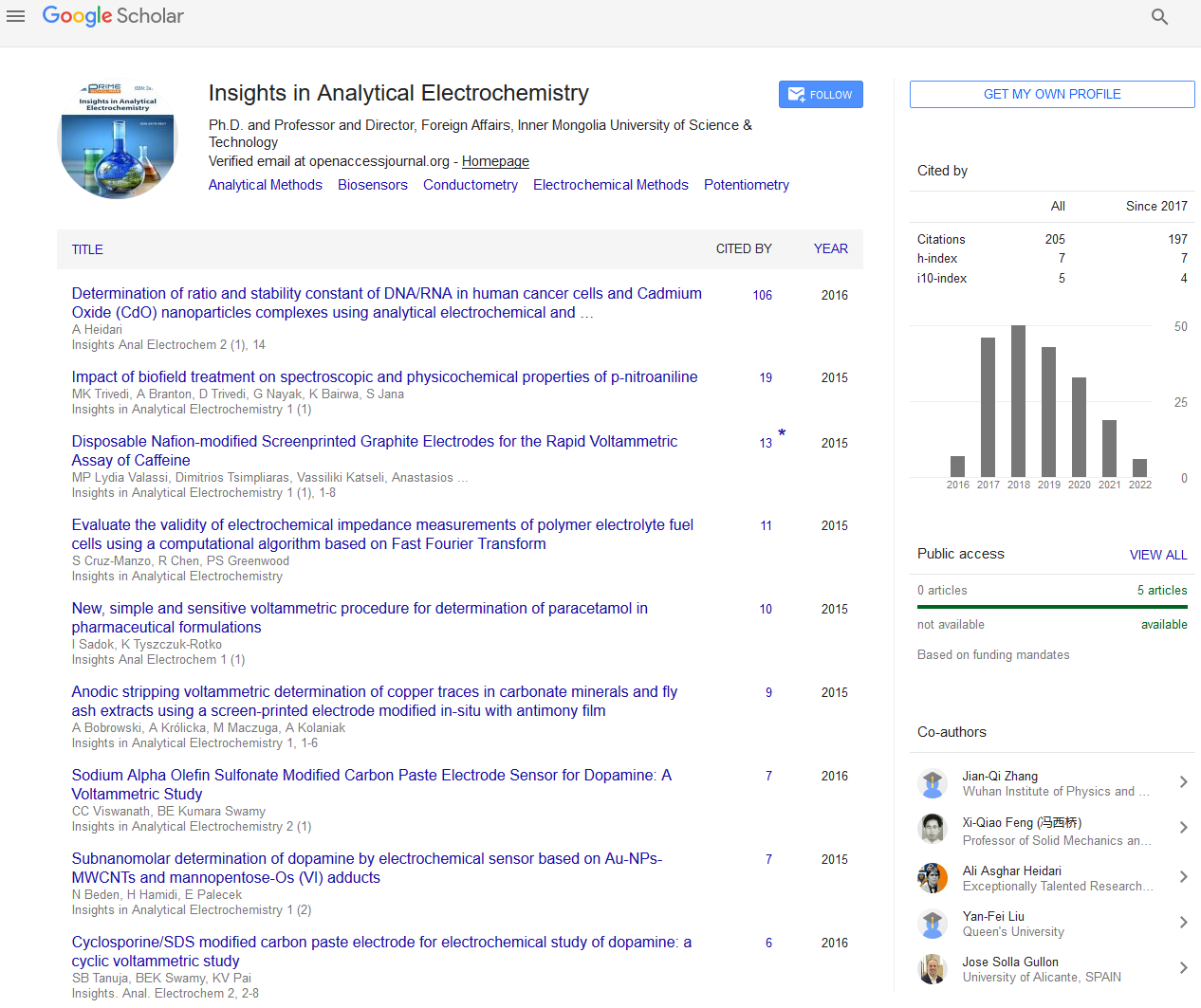Opinion - (2022) Volume 8, Issue 3
Whole Blood NADH Monitoring Using Biodegradable Electrocatalytic
Sensor
Lee Stark*
Department of Chemistry, University of Sydney, Australia
*Correspondence:
Lee Stark, Department of Chemistry, University of Sydney,
Australia,
Email:
Received: 02-May-2022, Manuscript No. ipaei-22-13621;
Editor assigned: 04-May-2022, Pre QC No. ipaei-22-13621(PQ);
Reviewed: 18-Apr-2022, QC No. ipaei-22-13621;
Revised: 23-May-2022, Manuscript No. ipaei-22-13621(R);
Published:
30-May-2022, DOI: 10.21767 / 2470-9867 - 8.3.14
Introduction
In the study, the preparation and electrochemical characterization
of screenprinted electrodes (SPE) modified with 4mercaptoNphenylquinone
diamine (NPQD) and their behavior as
electrocatalysts toward the oxidation of NADH with high stability
are described. In particular, NPQD on the SPE substrate
was deposited via electropolymerization. In all cases, NADH oxidation
occurred at potentials approximately corresponding to
0.7 V vs Ag/AgCl electrode, and this indicates a decrease in the
overpotential. We used the observations as a point of departure
and developed an NADH biosensor based on the electrocatalytic
oxidation of NADH. The applicability of the NADH sensor
was demonstrated for the first time in selectivity/sensitivity
test via complex electrolyte as cell culture inflammatory and
fibrotic responses by polyhexamethylene guanidine phosphate
via NADH sensing in mouse serum. The maintenance of mitochondrial
function is critical to preserving homeostasis in the
living cell. Mitochondria are the cornerstone of lifesupporting
metabolic processes such as energy transduction and calcium
signaling in biosynthetic pathways.
Description
Nicotinamide adenine dinucleotide, nicotinamide dinucleotide
phosphate (NADP), and flavin adenine dinucleotide (FAD) are
the most important coenzymes that exhibit a beneficial effect
on the mitochondrial state because ATP production depends
on the redox state of these coenzymes. Among them, NADH
is the most wellknown biomarker of the redox state of a cell.
Koidl group reported that NADH deficiency causes an energy
production problem and induces Parkinson`s disease due to
the lack of ATP. The conventional method to determine NADH corresponds to an optical assay using absorbance4 or fluorescence
and a colorimeter. The aforementioned methods are robust
and standardized analytical methods to determine NADH.
They also require high maintenance costs and high sample
volume, and they exhibit a low limit of detection (LOD). Electrochemical
(EC) biosensors for NADH emerged as an alternative
analytical tool to conventional methods. The EC biosensor
exhibits several advantages including convenience and short
analysis time, and they require a small sample volume while
maintaining high sensitivity and selectivity.. However, there
were some restrictions. In other words, there is great potential
to oxidize NADH. This destroys the electrode surface due to
the fouling effect and reduces efficiency. This is because the
redox reaction easily forms NAD + on the electrode surface at
the beginning of development.
Conclusion
To solve the problem, a single mediator K3Fe (CN), polymer,
using different sensor configurations using an electrode-catalyzed
enzymatic reaction induced by surface modification to
lower the redox potential of NADH. Several studies have been
done. While each method has significant advantages, the development
of fast, inexpensive, and accurate methods to maintain
sensitivity remains important in the field of NADH-EC sensors.
Shown is a screen-printed cathode (SPE) based biosensor
with an anode impetus immobilized on the SPE by surface adjustment
to bring down the redox capability of the NADH/NAD
+ couple. SPE is a promising insightful apparatus as a minimal
expense NADH biosensor stage. Also, we concentrated on terminal
catalyzed responses in complex media and demonstrated
that the proposed sensor keeps up with its responsiveness
by decreasing the impedance signal.
Citation: Stark L(2022) Whole Blood NADH Monitoring Using Biodegradable Electrocatalytic Sensor. Insights Anal Electrochem.8:14
Copyright: ©Stark L. This is an open-access article distributed under the terms of the Creative Commons Attribution License,
which permits unrestricted use, distribution, and reproduction in any medium, provided the original author and source are
credited.

